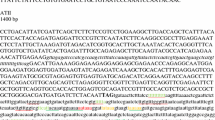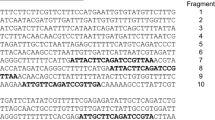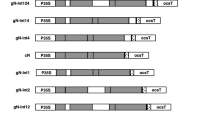Abstract
Intron-bearing replacement histone H3 genes in Arabidopsis and other plants are highly and constitutively expressed. We demonstrate that the introns located within the 5′-untranslated regions (5′-UTR) of the two Arabidopsis replacement H3 genes will abolish the cell cycle dependence of an endogenous histone H4 promoter. We demonstrate that these introns, functionally combined with their endogenous promoters, could produce the high and constitutive expression of the replacement H3 genes observed in planta. They strongly increase gene expression whatever the promoter, from the strong 35S CaMV promoter to complete and resected promoters of cell cycle-dependent and replacement histone genes. Quantitative analysis of the extent of reporter gene enhancement in different parts of developing transgenic plantlets, ranging from 2-fold to 70-fold, supports the notion that trans-acting factors are responsible for this effect. Such factors appear most abundant in roots.
Similar content being viewed by others
References
Atanassova, R., Chaubet, N. and Gigot, C. 1992. A 126 bp fragment of a plant histone gene promoter confers preferential expression in meristems of transgenic Arabidopsis. Plant J. 2: 291-300.
Bevan, M. 1984. Binary Agrobacterium vectors for plant transfor-mation. Nucl. Acids Res. 12: 8711-8721.
Bhattacharyya, N. and Banerjee, D. 1999. Transcriptional regula-tory sequences within the first intron of the chicken apolipopro-tein AI (apoAI) gene. Gene 234: 371-380.
Bradford, M.M. 1976. A rapid and sensitive method for the quanti-tation of microgram quantities of protein utilizing the principle of protein-dye binding. Anal. Biochem. 72: 248-254.
Brignon, P. and Chaubet, N. 1993. Constitutive and cell-division-inducible protein-DNA interactions in two maize histone gene promoters. Plant J. 4: 445-457.
Callis, J., Fromm, M. and Walbot, V. 1987. Introns increase gene expression in cultured maize cells. Genes Dev. 1: 1183-1200.
Chaboute, M.E., Chaubet, N., Philipps, G., Ehling, M. and Gigot, C. 1987. Genomic organization and nucleotide sequences of two histone H3 and two histone H4 genes of Arabidopsis thaliana. Plant Mol. Biol. 8: 179-191.
Chaubet, N., Clement, B. and Gigot, C. 1992. Genes encoding a histone H3.3-like variant in Arabidopsis contain intervening sequences. J. Mol. Biol. 225: 569-574.
Chaubet, N., Flenet, M., Clement, B., Brignon, P. and Gigot, C. 1996. Identification of cis-elements regulating the expression of an Arabidopsis histone H4 gene. Plant J. 10: 425-435.
Gallie, D.R. and Young, T.E. 1994. The regulation of gene expres-sion in transformed maize aleurone and endosperm protoplasts. Plant Physiol. 106: 929-939.
Gardner, R.C., Howarth, A.J., Hahn, P., Brown-Luedi, M., Shep-herd, R.J. and Messing, J. 1981. The complete nucleotide se-quence of an infectious clone of cauliflower mosaic virus by M13mp7 shotgun sequencing. Nucl. Acids Res. 9: 2871-2888.
Gidekel, M., Jimenez, B. and Herrera-Estrella, L. 1996. The first intron of the Arabidopsis thaliana gene coding for elongation factor 1_ contains an enhancer-like element. Gene 170: 201-206.
Jefferson, R.A., Kavanagh, T.A. and Bevan, M.W. 1987. GUS fu-sion: 1_-glucuronidase as a sensitive and versatile gene fusion marker in higher plants. EMBO J. 6: 3901-3907.
Kanazin, V., Blake, T. and Shoemaker, R.C. 1996. Organization of the histone H3 genes in soybean, barley and wheat. Mol. Gen. Genet. 250: 137-147.
Kapros, T., Robertson, A.J. and Waterborg, J.H. 1995. Histone H3 transcript stability in alfalfa. Plant Mol. Biol. 28: 901-914.
Kapros, T., Stefanov, I. Magyar, Z., Ocsovszky, I. and Dudits, D. 1998. A short histone H3 promoter from alfalfa specifies expres-sion in S phase cells and meristems. In Vitro Cell Dev. Biol. 29: 27-32.
Lepetit, M., Ehling, M., Chaubet, N. and Gigot, C. 1992. A plant histone gene promoter can direct both replication-dependent and-independent gene expression in transgenic plants. Mol. Gen. Genet. 231: 276-285.
Luehrsen, K.R. and Walbot, V. 1991. Intron enhancement of gene expression and the splicing efficiency of introns in maize cells. Mol. Gen. Genet. 225: 81-93.
Mascarenhas, D., Mettler, I.J., Pierce, D.A. and Lowe, H.W. 1990. Intron-mediated enhancement of heterologous gene expression in maize. Plant Mol. Biol. 15: 913-920.
O'Donnell, K.H. and Wensink, P.C. 1994. GAGA factor and TBF1 bind DNA elements that direct ubiquitous transcription of the _1-tubulin gene. Nucl. Acids Res. 22: 4712-4718.
Ohtsubo, N., Nakayama, T., Kaya, H., Terada, R., Shimamoto, K., Meshi, T. and Iwabuchi, M. 1997. Cooperation of two distinct cis-acting elements is necessary for the S phase-specific activa-tion of the wheat histone H3 promoter. Plant J. 11: 1219-1226.
Rethmeier, N., Seurinck, J., Van Montagu, M. and Cornelissen, M. 1997. Intron-mediated enhancement of transgene expression in maize is a nuclear, gene-dependent process. Plant J. 12: 895-899.
Robertson, A.J., Kapros, T., Dudits, D. and Waterborg, J.H. 1996. Identification of three highly expressed replacement histone H3 genes of alfalfa. DNA Seq. 6: 137-146.
Robertson, A.J., Kapros, T. and Waterborg, J.H. 1997. A cell cycle-regulated histone H3 gene of alfalfa with an atypical promoter structure. DNA Seq. 7: 209-216.
Rose, A.B. and Beliakoff, J.A. 2000. Intron-mediated enhancement of gene expression independent of unique intron sequences and splicing. Plant Physiol. 122: 535-542.
Shen, W.H. and Gigot, C. 1997. Protein complexes binding to cis elements of the plant histone gene promoters: multiplicity phosphorylation and cell cycle alteration. Plant Mol. Biol. 33: 367-380.
Snowden, K.C., Buchholz, W.G. and Hall, T.C. 1996. Intron posi-tion affects expression from the tpi promoter in rice. Plant Mol. Biol. 31: 689-692.
Tanaka, A., Mita, S., Ohta, S., Kyozuka, J., Shimamoto, K. and Nakamura, K. 1990. Enhancement of foreign gene expression by a dicot intron in rice but not in tobacco is correlated with an increased level of mRNA and an efficient splicing of the intron. Nucl. Acids Res. 18: 6767-6770.
Taoka, K., Ohtsubo, N., Fujimoto, Y., Mikami, K., Meshi, T. and Iwabuchi, M. 1998. The modular structure and function of the wheat H1 promoter with S phase-specific activity. Plant Cell Physiol. 39: 294-306.
Terada, R., Nakayama, T., Iwabuchi, M. and Shimamoto, K. 1995. A Type I element composed of hexamer wheat histone (ACGTCA) and octamer (CGCGGATC) motifs plays a role(s) in meristematic expression of a wheat histone H3 gene in transgenic rice plants. Plant Mol. Biol. 27: 17-26.
Topfer, R., Matzeit, V., Gronenborn, B., Schell, J. and Steinbiss, H.H. 1987. A set of plant expression vectors for transcriptional and translational fusions. Nucl. Acids Res. 15: 5890.
Tsukiyama, T., Becker, P.B. and Wu, C. 1994. ATP-dependent nucleosome disruption at a heat-shock promoter mediated by binding of GAGA transcription factor. Nature 367: 525-532.
Valvekens, D., Van Montagu, M. and Van Lijsebettens, M. 1988. Agrobacterium tumefaciens-mediated transformation of Ara-bidopsis thaliana root explants by using kanamycin selection. Proc. Natl. Acad. Sci. USA85: 5536-5540.
Wall, G., Varga-Weisz, P.D., Sandaltzopoulos, R. and Becker, P.B. 1995. Chromatin remodeling by GAGA factor and heat shock factor at the hypersensitive Drosophila hsp26 promoter in vitro. EMBO J. 14: 1727-1736.
Warnecke, C., Willich, T., Holzmeister, J., Bottari, S.P., Fleck, E. and Regitz-Zagrosek, V. 1999. Efficient transcription of the human angiotensin II type 2 receptor gene requires intronic sequence elements. Biochem. J. 340: 17-24.
Waterborg, J.H. 1992. Existence of two histone H3 variants in di-cotyledonous plants and correlation between their acetylation and plant genome size. Plant Mol. Biol. 18: 181-187.
Waterborg, J.H. 1993. Histone synthesis and turnover in alfalfa. Fast loss of highly acetylated replacement histone H3.2. J. Biol. Chem. 268: 4912-4917.
Waterborg, J.H. and Robertson, A.J. 1993. Efficient large-scale purification of restriction fragments by solute-displacement ion-exchange HPLC. Nucl. Acids Res. 21: 2913-2915.
Waterborg, J.H. and Robertson, A.J. 1996. Common features of analogous replacement histone H3 genes in animals and plants. J. Mol. Evol. 43: 194-206.
Author information
Authors and Affiliations
Rights and permissions
About this article
Cite this article
Chaubet-Gigot, N., Kapros, T., Flenet, M. et al. Tissue-dependent enhancement of transgene expression by introns of replacement histone H3 genes of Arabidopsis. Plant Mol Biol 45, 17–30 (2001). https://doi.org/10.1023/A:1006487023926
Issue Date:
DOI: https://doi.org/10.1023/A:1006487023926




